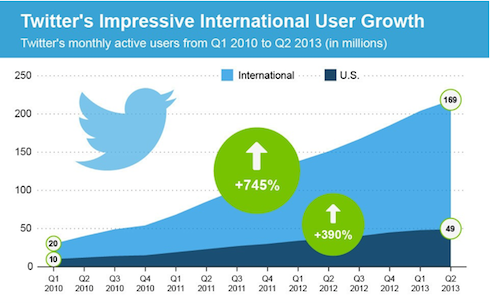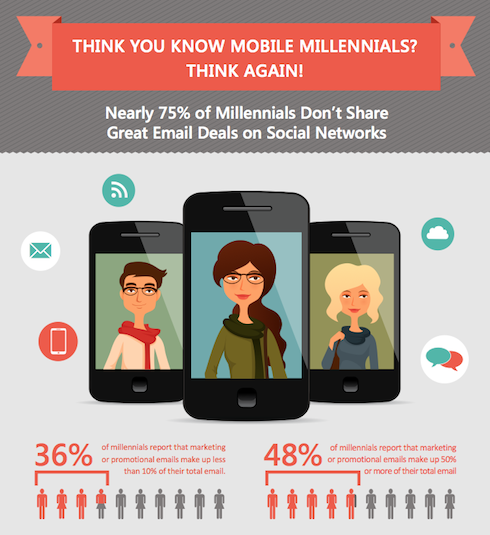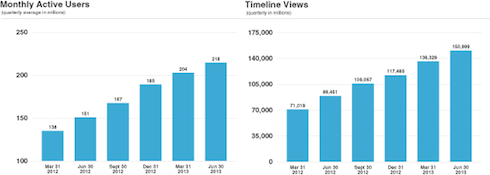By Nick Johnson - October 7th, 2013
Combating social spam, the geography of social media and ads sweep across the social space
Where are your followers?
Savvy marketers have known for years that segmenting their databases for highly targeted messaged can be an effective engagement mechanism. But does your corporation also look closely at the geographical dispersal of those segmented groups?
Focusing on just Twitter, a new piece of statistical analysis from Statista makes for interesting reading if your business wants to know where most of its Twitter followers are located.
Twitter has had a meteoric rise to dominance with a reported 745% expansion between 2010 and 2013 with its user base now standing at 169 million. However, if you thought most of this growth was in North America, think again, as this area’s user base only grew by 390% over the same period.
For corporations looking for ways to make closer connections with their existing customers, and to reach new consumers, this data is vital, as marketers are realising that their engagement messages must be tailored to the sensibilities of each geographic group.

Social spam on the increase
Spam has been the scourge of the Internet since its inception, with little attention paid to this phenomenon across the social media networks. New research from Nexgate’s State of Social Media Spam report reveals that this is a growing issue.
The report states: “Today, social media spam (or “social spam”) is on the rise. During the first half of 2013, there has been a 355% growth of social spam on a typical social media account. Spammers are turning to the fastest growing communications medium to circumvent traditional security infrastructures that were used to detect email spam.
“The impact of social media spam is already significant - it can damage brand appearance and turn fans and followers into foes. To make matters worse, a spammy social message isn’t just seen by one recipient, but by potentially all of the brand’s followers and all of the recipients’ friends. Social spam transforms one of the greatest assets of social media marketing – it’s multi-dimensional nature – against the brand.”
Devin Redmond, CEO of Nexgate, said: “Just like previous mediums such as email, social spam is becoming a real business for spammers. You can see it in the increasing sophistication and diversification of the mechanisms used to distribute spam, and not just in the increase in volume. The fact that spam is reportedly a $200 million business in Facebook alone, and it’s delivered via a variety of bots, spam networks, and in multiple spam communication types is proof positive that this is real and thriving part of the social media world.”
For corporations this kind of spam is potentially much more damaging than current varieties. It’s important that all brands are vigilant as social media offers a massive opportunity for spammers to reach a wide audience very quickly at the expanse of the brand owners.
![]()
Millennials won’t share
If your corporation is chasing the much-coveted 18-34 age group, it looks like your marketing campaigns must go mobile. At the moment this group numbers 86 million in the US alone, so is a significant market to pursue. However, according to research from Campaigner this group are rather picky when it comes to what they share across their social networks.
The survey results are revealing and will have a massive impact on how brands develop their marketing messages: Opening email on mobile devices is practised by over 60% of Millennials. Nearly 20% will open emails because of intriguing subject lines, with nearly three-quarters stating they would not share offers across their social media group they had received in these email messages.
Campaigner advise:
- Up Your Social Game: To capture the attention of the most socially networked generation to date, give them an easy way to share great sales or promotions. Dedicating a small amount of space in a mobile marketing email for potential customers to share information on their social networks is an easy effort to make as a means to increase your millennial customer base. If you really want to get them hooked – set up a rewards program for sharing.
- Go Mobile-friendly, or Go Home: Since Millennials are exceptionally mobile-savvy; they lose patience with clunky, non-mobile optimized emails in an instant. Make sure the size and style of the fonts used is readable, use big call-to-action buttons for easy tapping and mobile devices, and ALWAYS ensure that mobile marketing emails link back to a mobile-optimized site or landing page. To cover your bases with responsive mobile design, more tips can be found here.
- Know Your Millennials (better than they know themselves): The last thing you want a Millennial to do is not to open your email – or worse – read your email headline, and delete it because it doesn’t relate to them. Millennials have grown up in the age of on-demand, personalized everything, so it’s critical to go the extra mile with personalization in an effort to impress and/or reassure them that you know what they want, when they want it, before they even do.

Social ads expand
As each of the social media networks moves towards their inevitable IPO, the question of ad-supported revenue raises its head. Twitter is the latest to lay bare its financials that many have been poring over for days. The so-called advertising revenue per timeline view is an intriguing metric that many marketers have been closing assessing. Tech Crunch report:
“Twitter brought in $253 million in revenue in the first six months of the year. Of that amount, $221 million (87%) came from ads, compared to $32 million (13%) from data licensing. In comparison, the company made $7 million from advertising in all of 2010 (that’s when it launched its first ad programs) and $21 million from data licensing. Oh, and Twitter says that mobile accounts for 65% of its ad revenue.”
For brand owners understanding how each of the social media networks they maintain a presence on uses ads is critical to ensure these are leveraged to their maximum potential. And with news that Instagram will also be using ads soon, social media is suddenly an ad driven space. And marketing messages coupled with ads must also go mobile, as Twitter states:
“Mobile has become the primary driver of our business. Our mobile products are critical to the value we create for our users, and they enable our users to create, distribute and discover content in the moment and on-the-go. The 140 character constraint of a Tweet emanates from our origins as an SMS-based messaging system, and we leverage this simplicity to develop products that seamlessly bridge our user experience across all devices. In the three months ended June 30, 2013, 75% of our average MAUs (Mobile Active Users) accessed Twitter from a mobile device, including mobile phones and tablets, and over 65% of our advertising revenue was generated from mobile devices. We expect that the proportion of active users on, and advertising revenue generated from, mobile devices, will continue to grow in the near term."

Until next time….
The Useful Social Media team.
Next Reads
October 2013, New York
How you can leverage social media for a more effective customer service function and better customer insight
Brochure Programme